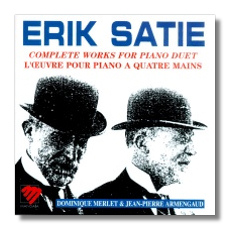
The Internet's Premier Classical Music Source
Related Links
- Satie Reviews
- Latest Reviews
- More Reviews
-
By Composer
-
Collections
DVD & Blu-ray
Books
Concert Reviews
Articles/Interviews
Software
Audio
Search Amazon
Recommended Links
Site News
 CD Review
CD Review
Erik Satie

Music for Piano 4-Hands
- Parade
- Trois petites pieces montees
- En habit de cheval
- Trois morceaux en forme de poire
- Apercus desagreables
- La Belle Excentrique
Jean-Pierre Armengaud, piano
Dominique Merlet, piano
Mandala 4882 52min
This disc contains all of Satie's music for piano duet. Armengaud has written a fairly well-received book on the composer, Les plus que breves d'Erik Satie. From a technical point of view, Merlet and Armengaud play superbly. They attack together in music which exposes the attack, they clarify all the lines, they keep the rhythms and the ornaments crisp. This is playing of great refinement, and the engineers have captured it well.
Unfortunately, Merlet and Armengaud also hold a view of Satie's music I don't share. They see him as refined, witty, and ascetic, with an underlying sadness. That's fine. However, for me, Satie, especially in most of the music here, is also a great deal of fun. I miss that in these performances. There's wit in their account, but it's wit without pleasure. The music proceeds with relentless good taste. Satie flirts with low taste as a regularly recurring feature of his style: popular dances (cafe waltzes, polkas, even Irving Berlin ragtime in Parade and the Trois petites pieces montees), sendups of fugues, and brass-band marches, as well as rude tromps through musical reveries and, conversely, breaking off high spirits for muted regrets. With the exception of Socrate, the Messe des pauvres, and the Rosicrucian pieces, Satie usually caroms between these two moods. His joy in the world stands off a bit, somewhat voyeuristically, tempered by the melancholy of its short life. On the other hand, his sense of the ridiculous keeps him from wallowing.
Consequently, the performers' accounts come off as a mixed bag. In the quieter parts of Trois morceaux (which consists of seven sections, by the way) and in the first movement of Trois pieces montees, they do just fine. The end of Parade is beautiful. On the other hand, the "Coin de polka" of Trois pieces and the "Ragtime du paquebot" of Parade sound like Clementi – pleasant, agreeable, but a bit sedate. En habit de cheval's opening chords come over as merely tasteful – like Queen Victoria expressing personal displeasure – rather than the jabs or grotesque grimaces I want from the music. Wyneke Jordans and Leo van Doeselaar's account of the same repertoire on Etcetera 1015 is not nearly as well-played or recorded as this, but I think it comes much closer to the spirit of Satie.
Copyright © 1996, Steve Schwartz


















